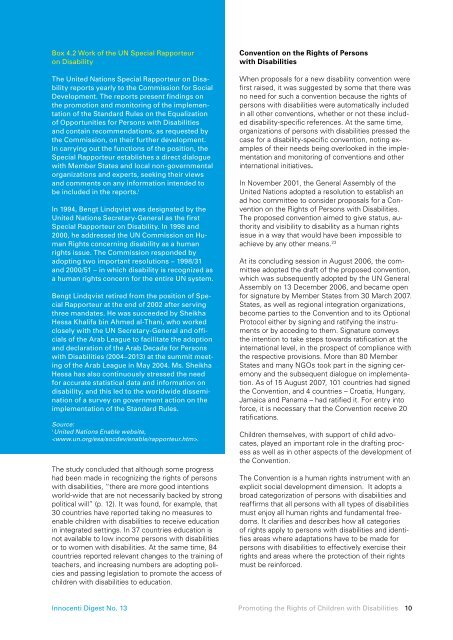Promoting the Rights of Children with Disabilities, UNICEF
Promoting the Rights of Children with Disabilities, UNICEF
Promoting the Rights of Children with Disabilities, UNICEF
- No tags were found...
You also want an ePaper? Increase the reach of your titles
YUMPU automatically turns print PDFs into web optimized ePapers that Google loves.
Box 4.2 Work <strong>of</strong> <strong>the</strong> UN Special Rapporteuron DisabilityThe United Nations Special Rapporteur on Disabilityreports yearly to <strong>the</strong> Commission for SocialDevelopment. The reports present findings on<strong>the</strong> promotion and monitoring <strong>of</strong> <strong>the</strong> implementation<strong>of</strong> <strong>the</strong> Standard Rules on <strong>the</strong> Equalization<strong>of</strong> Opportunities for Persons <strong>with</strong> <strong>Disabilities</strong>and contain recommendations, as requested by<strong>the</strong> Commission, on <strong>the</strong>ir fur<strong>the</strong>r development.In carrying out <strong>the</strong> functions <strong>of</strong> <strong>the</strong> position, <strong>the</strong>Special Rapporteur establishes a direct dialogue<strong>with</strong> Member States and local non-governmentalorganizations and experts, seeking <strong>the</strong>ir viewsand comments on any information intended tobe included in <strong>the</strong> reports. iIn 1994, Bengt Lindqvist was designated by <strong>the</strong>United Nations Secretary-General as <strong>the</strong> firstSpecial Rapporteur on Disability. In 1998 and2000, he addressed <strong>the</strong> UN Commission on Human<strong>Rights</strong> concerning disability as a humanrights issue. The Commission responded byadopting two important resolutions − 1998/31and 2000/51 − in which disability is recognized asa human rights concern for <strong>the</strong> entire UN system.Bengt Lindqvist retired from <strong>the</strong> position <strong>of</strong> SpecialRapporteur at <strong>the</strong> end <strong>of</strong> 2002 after servingthree mandates. He was succeeded by SheikhaHessa Khalifa bin Ahmed al-Thani, who workedclosely <strong>with</strong> <strong>the</strong> UN Secretary-General and <strong>of</strong>ficials<strong>of</strong> <strong>the</strong> Arab League to facilitate <strong>the</strong> adoptionand declaration <strong>of</strong> <strong>the</strong> Arab Decade for Persons<strong>with</strong> <strong>Disabilities</strong> (2004−2013) at <strong>the</strong> summit meeting<strong>of</strong> <strong>the</strong> Arab League in May 2004. Ms. SheikhaHessa has also continuously stressed <strong>the</strong> needfor accurate statistical data and information ondisability, and this led to <strong>the</strong> worldwide dissemination<strong>of</strong> a survey on government action on <strong>the</strong>implementation <strong>of</strong> <strong>the</strong> Standard Rules.Source:iUnited Nations Enable website,.The study concluded that although some progresshad been made in recognizing <strong>the</strong> rights <strong>of</strong> persons<strong>with</strong> disabilities, “<strong>the</strong>re are more good intentionsworld-wide that are not necessarily backed by strongpolitical will” (p. 12). It was found, for example, that30 countries have reported taking no measures toenable children <strong>with</strong> disabilities to receive educationin integrated settings. In 37 countries education isnot available to low income persons <strong>with</strong> disabilitiesor to women <strong>with</strong> disabilities. At <strong>the</strong> same time, 84countries reported relevant changes to <strong>the</strong> training <strong>of</strong>teachers, and increasing numbers are adopting policiesand passing legislation to promote <strong>the</strong> access <strong>of</strong>children <strong>with</strong> disabilities to education.Convention on <strong>the</strong> <strong>Rights</strong> <strong>of</strong> Persons<strong>with</strong> <strong>Disabilities</strong>When proposals for a new disability convention werefirst raised, it was suggested by some that <strong>the</strong>re wasno need for such a convention because <strong>the</strong> rights <strong>of</strong>persons <strong>with</strong> disabilities were automatically includedin all o<strong>the</strong>r conventions, whe<strong>the</strong>r or not <strong>the</strong>se includeddisability-specific references. At <strong>the</strong> same time,organizations <strong>of</strong> persons <strong>with</strong> disabilities pressed <strong>the</strong>case for a disability-specific convention, noting examples<strong>of</strong> <strong>the</strong>ir needs being overlooked in <strong>the</strong> implementationand monitoring <strong>of</strong> conventions and o<strong>the</strong>rinternational initiatives.In November 2001, <strong>the</strong> General Assembly <strong>of</strong> <strong>the</strong>United Nations adopted a resolution to establish anad hoc committee to consider proposals for a Conventionon <strong>the</strong> <strong>Rights</strong> <strong>of</strong> Persons <strong>with</strong> <strong>Disabilities</strong>.The proposed convention aimed to give status, authorityand visibility to disability as a human rightsissue in a way that would have been impossible toachieve by any o<strong>the</strong>r means. 23At its concluding session in August 2006, <strong>the</strong> committeeadopted <strong>the</strong> draft <strong>of</strong> <strong>the</strong> proposed convention,which was subsequently adopted by <strong>the</strong> UN GeneralAssembly on 13 December 2006, and became openfor signature by Member States from 30 March 2007.States, as well as regional integration organizations,become parties to <strong>the</strong> Convention and to its OptionalProtocol ei<strong>the</strong>r by signing and ratifying <strong>the</strong> instrumentsor by acceding to <strong>the</strong>m. Signature conveys<strong>the</strong> intention to take steps towards ratification at <strong>the</strong>international level, in <strong>the</strong> prospect <strong>of</strong> compliance <strong>with</strong><strong>the</strong> respective provisions. More than 80 MemberStates and many NGOs took part in <strong>the</strong> signing ceremonyand <strong>the</strong> subsequent dialogue on implementation.As <strong>of</strong> 15 August 2007, 101 countries had signed<strong>the</strong> Convention, and 4 countries – Croatia, Hungary,Jamaica and Panama – had ratified it. For entry int<strong>of</strong>orce, it is necessary that <strong>the</strong> Convention receive 20ratifications.<strong>Children</strong> <strong>the</strong>mselves, <strong>with</strong> support <strong>of</strong> child advocates,played an important role in <strong>the</strong> drafting processas well as in o<strong>the</strong>r aspects <strong>of</strong> <strong>the</strong> development <strong>of</strong><strong>the</strong> Convention.The Convention is a human rights instrument <strong>with</strong> anexplicit social development dimension. It adopts abroad categorization <strong>of</strong> persons <strong>with</strong> disabilities andreaffirms that all persons <strong>with</strong> all types <strong>of</strong> disabilitiesmust enjoy all human rights and fundamental freedoms.It clarifies and describes how all categories<strong>of</strong> rights apply to persons <strong>with</strong> disabilities and identifiesareas where adaptations have to be made forpersons <strong>with</strong> disabilities to effectively exercise <strong>the</strong>irrights and areas where <strong>the</strong> protection <strong>of</strong> <strong>the</strong>ir rightsmust be reinforced.Innocenti Digest No. 13<strong>Promoting</strong> <strong>the</strong> <strong>Rights</strong> <strong>of</strong> <strong>Children</strong> <strong>with</strong> <strong>Disabilities</strong>10
















